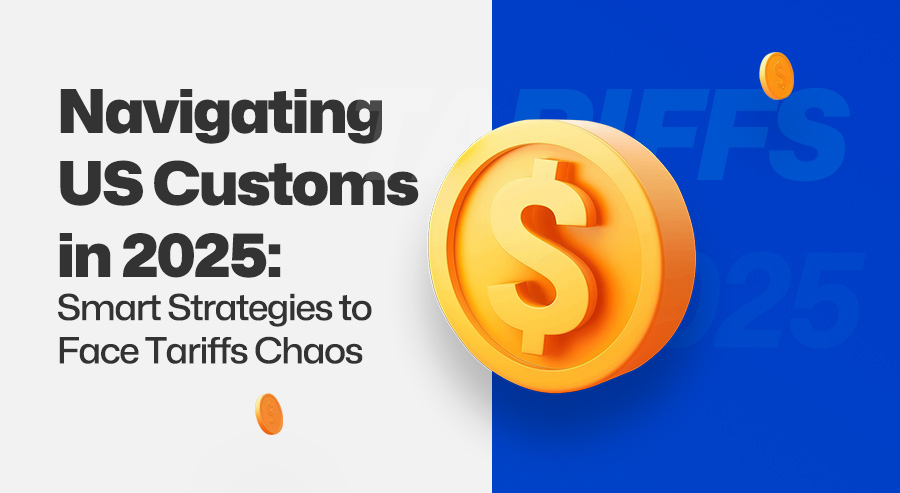n 2025, U.S. trade policy is experiencing its most disruptive shift in years. The global trade landscape is rapidly evolving as new tariffs take effect. For e-commerce brands, particularly those dependent on global fulfillment and low-margin products, these changes represent a critical turning point. Understanding what’s happening is essential, so let’s break down what you need to know and how to prepare with a clear action plan for 2025.

Understanding Tariffs and De Minimis
What are Tariffs?
Tariffs are taxes or duties imposed by a government on imported goods. They’re used to generate revenue, protect domestic industries, or influence foreign trade relationships. Most tariffs fall into two categories:
- Ad valorem tariffs are calculated as a percentage of the product’s declared value—for example, a 10% tariff on a $1,000 item would result in $100 in duties.
- Specific tariffs are a fixed amount charged per unit, no matter what the item is worth—for example, $2 per item, whether it costs $10 or $100.
U.S. Tariffs: Key Dates & Highlights so Far
February 4, 2025
- 10% tariffs imposed on all Chinese imports.
March 4, 2025
- Additional 10% tariffs on all Chinese goods.
April 2, 2025
- Announces Liberation Day, the start of a fresh set of tariffs that will impact “all countries.”
April 3, 2025
- Announces additional 34% duties on all Chinese imports, effective April 9.
April 9, 2025
- Raises tariffs on Chinese imports to 125%.
- Pauses higher duties for other countries for 90 days.
April 11, 2025
- Total U.S. tariffs on Chinese goods reached 145% after clarification that 125% was added to a previous 20%.
April 13, 2025
- Smartphones, computer monitors, and various electronic parts exempted from new tariffs. Exemption applies retroactively to products entering the U.S. or removed from warehouses as early as April 5th.
View the full U.S. Tariff Rates by Country list
What’s Changing in 2025: De Minimis and Tariff Updates
What is De Minimis?
De minimis refers to the threshold below which imported goods can enter a country duty-free or with simplified customs clearance. For e-commerce brands, this threshold plays a key role in keeping cross-border shipping cost-effective, especially for low-value, direct-to-consumer (DTC) orders.
Since 2016, the U.S. de minimis threshold has been $800 per person, per day, offering a significant advantage to e-commerce brands by reducing landed costs and avoiding delays through a simplified customs clearance process.
Upcoming changes
The trade policy updates announced on April 2 mark a substantial adjustment in how e-commerce imports are taxed and processed at the border. Brands that ship globally need to keep up with these critical developments to avoid added costs and compliance issues.
De Minimis Is Ending
The U.S. government has confirmed plans to eliminate the de minimis exemption for all countries once customs systems are equipped to support full enforcement. For now, the most immediate changes apply to shipments from China and Hong Kong:
- May 2: De minimis ends for all goods from China and Hong Kong—shipments of any value will require formal customs entry and duties. Postal shipments will be subject to a 120% tariff or $100 per item, depending on the valuation method selected by the carrier.
- June 1: The flat-rate postal tariff increases to $150 per item (up from the previous $100 rate)
These updates phase out a long-standing cost-saving tool for DTC brands shipping low-value parcels and are expected to significantly increase landed costs for many e-commerce businesses.
How Will the April 2025 Tariffs Impact E-commerce Brands?
For merchants, the implications of these new tariffs and the end of de minimis will depend heavily on sourcing, fulfillment models, and shipping strategy. Understanding how these policy updates affect different business types is key to identifying the right operational adjustments.
1. Brands Shipping China-Made Products Directly to the U.S.
What to Expect:
- A 145%, as well as any previously existing duties that may still apply
- The end of de minimis on May 2, removing duty-free entry for low-value shipments
- Postal shipments from China will be subject to duties beginning May 2, with a rate of 120% or $100 per item—increasing to $150 per item on June 1
2. Brands Shipping China-Made Products but Fulfilling From the U.S.
What to Expect:
- Higher import costs when bringing inventory into the U.S. from China
- Fluctuating freight costs as carriers respond to shifting demand—including early spikes as brands rush to reposition inventory, followed by potential drop-offs
3. Brands Sourcing/Shipping from Outside of China (e.g., Vietnam, India)
What to Expect:
- Continued access to the U.S. $800 de minimis—for now (though bulk imports are subject to reciprocal tariffs, including 10% for Vietnam and India)
- A planned global phaseout of the de minimis exemption once systems are in place
Shipping Declarations Overview: T11, T01, and T86.
(A) T11 Declaration: Single Package, Single Declaration
- How it works: Each package is declared separately to customs (one package = one declaration).
- Costs:
- You pay customs fees and taxes for each package (since each is treated as its own “shipment”).
- You also pay the regular shipping fee.
(B) T01 Declaration: Multiple Packages/Bulk Shipments, Shared Declaration
- How it works: Multiple packages are grouped together and declared as one single shipment (e.g., your package + others’ packages combined).
- Costs:
- The shipping company handles customs and pays taxes as one big batch.
- These costs are already included in the shipping fee (you don’t pay extra taxes/fees separately).
(C) T86 Transshipment: Re-route Through 3rd Country
- How it works: Your package is sent from China → stops in a 3rd place (e.g., Vietnam/Taiwan/Korea) → then to the USA.
- The package is declared as coming from the 3rd country (not China).
- Tax benefit: If the package value is under $800, it’s tax-free when entering the USA (thanks to de minimis rule).
- Costs:
- You pay customs fees/taxes only if the package is over $800.
- Shipping fees still apply.
HTS (Harmonized Tariff Schedule of the United States): A classification system used by U.S. Customs to categorize imported goods, determine applicable tariff rates, and identify relevant customs regulatory requirements.
MPF (Merchandise Processing Fee): A user fee charged by U.S. Customs and Border Protection (CBP) on most goods imported into the United States. It is intended to offset the operational costs of customs processing.
PGA (Partner Government Agency): U.S. government agencies responsible for regulating and managing the import of restricted goods into the country.
Bill of Lading: A bill of lading or waybill is a document from a transportation to a shipper that highlights the details of a shipment.
Solution Hub: Ways to Adapt and Thrive
Solution 1: Go Global – Diversify Beyond the U.S.
Best for: Scaling brands and risk-averse sellers
- Explore fast-growing markets: Middle East, Africa, Europe
- Fast delivery lanes from China:
- Europe: 5–7 days
- Australia: 6–9 days
- Middle East: 6–8 days
Solution 2: T86 Transshipment: Smart Re-Routing via 3rd Country (with Risks)
Best for: Sellers still fulfilling from China whose product doesn’t have stable demand yet
- Ship to countries like Vietnam, Taiwan, Korea → then to the U.S.
- Qualify for the $800 rule.
- Key Notes:
- Still tax-free under $800
- We handle labeling, repacking, and customs clearance
- Slightly longer shipping times, but lower overall costs
Solution 3: U.S. Fulfillment Centers (3PLs)
Best for: Sellers with proven products with stable demand
- Local storage = fast shipping + no import tax per item
- Ideal for businesses with fewer SKUs and predictable sales
- We offer LCL Sea Freight Solutions
- Benefits:
- No last-mile delays
- Higher customer satisfaction
- Bulk shipping (DDP options available)
Adapting to shifting trade policies is essential for growth.
Conclusion: How to Prepare for 2025: Action Plan
- Understand your product’s tax structure: Each SKU is affected differently.
- Evaluate Your Inventory Strategy: Identify which products are stable enough to stock in the U.S. warehouses.
- Explore New Market Opportunities: Don’t rely solely on the U.S.—consider expanding globally
- Stay Informed: Keep an eye on policy updates and enforcement trends.
- Engage with your audience: If you increase your prices, use tools to gauge consumer behavior in response to pricing shifts.
Need help calculating duties or navigating the changes? Check out our full breakdown in the Tariffs Q&A Blog for expert answers and real-world examples.




